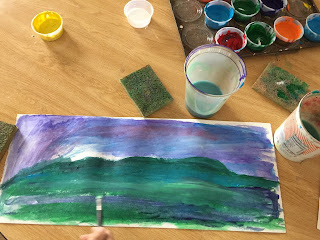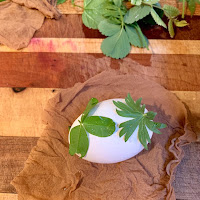Transitional Kindergarten: Zigzag Doll
ZIGZAG by Robert D. San Souci, a story about a doll maker who created Zigzag and placed him on the shelf for the night. After the doll maker left, Zigzag got pushed off the shelf by the other dolls. Zigzag ultimately ended up outside in the trash bin and had to climb his way out. The book does have a happy ending, as three mice found him a nice home with a happy little girl, and his zigzagged mouth turned into a happy smile.
The beginning of the story reveals that ZIGZAG was made from scraps of fabrics. TK students created their own dolls. Students picked out fabrics, used fabric scissors for cutting, and glued their fabrics where they wanted. Some dolls ended up with four legs, tails, and hats, and hair hanging off the edges, but that’s what makes these dolls so special! They make you smile!
Kindergarten: Joan Miró Dream Paintings
The unique style of surrealist painter, sculptor and ceramist Joan Miró (1893-1983) is characterized by the use of organic forms and flattened picture planes with sharp black lines.
In a similar fashion, students reviewed lines and geometric shapes and experimented with how these strict boundaries could be counterbalanced with the softness of color and more organic images. In his works, Miró often repeated surrealistic icons, objects and shapes such as: crescent moon, stars, figures with graphic patters, ladders, etc. Students were encouraged to include some of Miró's iconic objects or shapes in their own works.
1ST GRADE: Hundertwasser Spirals and Façade
First grade students were introduced to the painter and architect Friedensreich Hundertwasser (1928 – 2000). He was an Austrian-born New Zealand artist and architect who worked also in the field of environmental protection. His real name being Stowasser, his pseudonym Hundertwasser (by which he is known worldwide) comes from sto in Slavic languages, meaning "hundred".
He stood out as an opponent of "a straight line" and any standardization, expressing this concept in the field of building design. His best known work is considered the Hundertwasserhaus in Vienna, Austria which has become a notable place of interest in the Austrian capital characterized by imaginative vitality and uniqueness.
He was fascinated by spirals, and called straight lines "godless and immoral" and "something cowardly drawn with a rule, without thought or feeling". He called his theory of art "transautomatism", focusing on the experience of the viewer rather than the artist. This was encapsulated by his design of a new flag for New Zealand, which incorporated the image of the Koru a spiral shape based on the image of a new unfurling silver fern frond and symbolizing new life, growth, strength and peace according to the Māori people.
First grade students played with the element of the spiral and color and painted a "kunterbut" (German English translation multi-colored) background. Students were guided to deconstruct a tissue box and design a facade of a building. Inspired by Hundertwasser students experimented to alter the straight lines and angles of the tissue box into whimsical, innovative buildings. The spiral paintings served as a vibrant background for the magical buildings.
First grade students played with the element of the spiral and color and painted a "kunterbut" (German English translation multi-colored) background. Students were guided to deconstruct a tissue box and design a facade of a building. Inspired by Hundertwasser students experimented to alter the straight lines and angles of the tissue box into whimsical, innovative buildings. The spiral paintings served as a vibrant background for the magical buildings.
2nd GRADE:
Kandinsky Abstract Art: Painting Music Fast and Slow
Kandinsky Abstract Art: Painting Music Fast and Slow
One of the first modern abstract artists, Wassily Kandinsky (1866-1944), who was also an accomplished musician, hoped people would ‘hear’ his art, rather then appreciate it solely with their eyes.
In this project, students were introduce to Kandinsky’s concept of painting not what the artist saw, but what he or she heard and felt. While listening to the rhythms of both fast and slow music, students were encouraged to mix new colors, overlap shapes and designs. They closed their eyes and let their brushes and pens move freely to capture the music they heard.
3rd GRADE: Landscape Painting
A landscape painting has all the visible features of an area of countryside or land, often considered in terms of their aesthetic appeal. Pastoral, lush, dry, jagged, flat, or rolling, the landscape is nothing if not diverse. It calls to artists all over the world to photograph, study, and paint.
Third grade students were introduced to the basics of landscape painting. Students were working with the visual concepts of the horizon line, foreground, middle ground, and background. Students practiced to make artistic decisions such as; what to include, capturing interesting shapes, action lines, dividing the space in the painting, center of interest, or focal point etc. With tempera paint students painted stunning landscapes, experimenting with color mixing and textures.
Third grade students were introduced to the basics of landscape painting. Students were working with the visual concepts of the horizon line, foreground, middle ground, and background. Students practiced to make artistic decisions such as; what to include, capturing interesting shapes, action lines, dividing the space in the painting, center of interest, or focal point etc. With tempera paint students painted stunning landscapes, experimenting with color mixing and textures.
4th GRADE: California Watercolor Books
This lesson connects with the 4th grade studies on California. Fourth grade students experimented with four different watercolor techniques: sea salt, plastic wrap, wash with texture, and oil pastel resist.
Students created an accordion fold book out of watercolor paper and practiced each technique on one page of the book. Students worked with simple bookbinding techniques to create a front and back cover for their books.
On the back side of the accordion book, students painted a California landscape representing one of the four California regions (coast, mountains, desert, central valley). Students applied the watercolor techniques to the landscapes. As a finishing touch students wrote a thoughtful quote/poem in their books. The quote informs the viewer about an idea, emotion, or connection to the landscape that cannot be seen.
Students created an accordion fold book out of watercolor paper and practiced each technique on one page of the book. Students worked with simple bookbinding techniques to create a front and back cover for their books.
On the back side of the accordion book, students painted a California landscape representing one of the four California regions (coast, mountains, desert, central valley). Students applied the watercolor techniques to the landscapes. As a finishing touch students wrote a thoughtful quote/poem in their books. The quote informs the viewer about an idea, emotion, or connection to the landscape that cannot be seen.
































